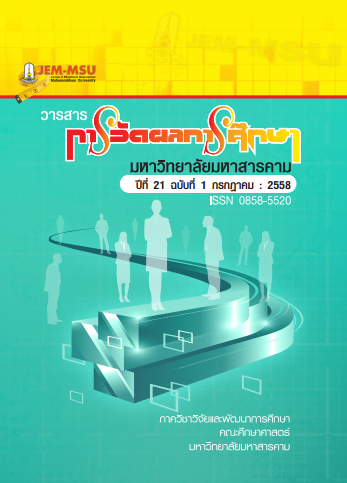Development of Expected Characteristics Indicators for Mahasarakham University’s Graduates
Main Article Content
Abstract
The purpose of this research was to develop the of expected
characteristics indicators for Mahasarakham University’s Graduates. The sample
used in this research consisted of 283 mahasarakham university lecturers
under 18 Faculties, obtained using Stratified Random Sampling technique.
The instruments used in collecting data was a 54–item 5-Rating scale
questionnaire, with discriminating powers (rxy) ranging 0.41– 0.91 and a
reliability of 0.99. The statistics used for data analysis were median, inter
quartile ranges, mean, standard deviation, and a confirmatory factor analysis.
The results of the study were as follows:
1. Expected characteristic indicators for Mahasarakham University’s
graduates had 6 aspects of core factors with totally 54 indicators. They
were classified into 9 characteristics of academic and professional knowledge,
14 indicators of morality, 14 indicators of personality, 4 indicators of
communication and information technology, 7 indicators of wisdom, and 6
indicators of human relations.
2. For the results of analyzing for examining congruence and
harmony of the construct model based on the theory and empirical
data, it was found that the construct model was in congruence in harmony
with the empirical data. The factors with the most important loading in
indicating desirable characteristics were wisdom, human relations and
personality. Harmony indicator between model and empirical data showed
the Chi-square = 1.67, p = 0.14, Degree of freedom (df) = 5, Goodness of
Fit Index (GFI) = 0.99, Adjusted Goodness of Fit Index (AGFI) = 0.96, Root
Mean Square of Error Approximation (RMSEA) = 0.049 it showed that the
model construct validity.
In conclusion, There finding indicators could be used of develop
the expected characteristic for Mahasarakham University’s Graduates.
Article Details
The content and information contained in the published article in the Journal of Educational Measurement Mahasarakham University represent the opinions and responsibilities of the authors directly. The editorial board of the journal is not necessarily in agreement with or responsible for any of the content.
The articles, data, content, images, etc. that have been published in the Journal of Educational Measurement Mahasarakham University are copyrighted by the journal. If any individual or organization wishes to reproduce or perform any actions involving the entirety or any part of the content, they must obtain written permission from the Journal of Educational Measurement Mahasarakham University.

